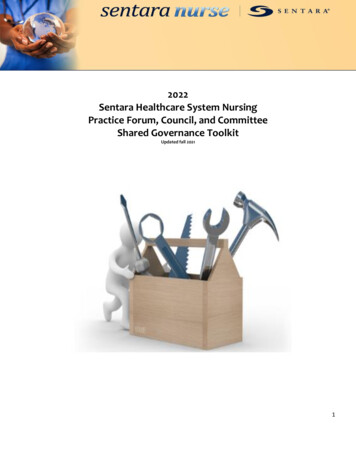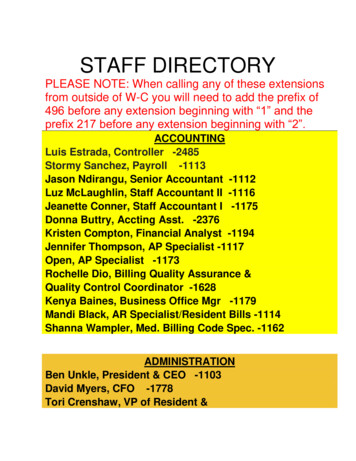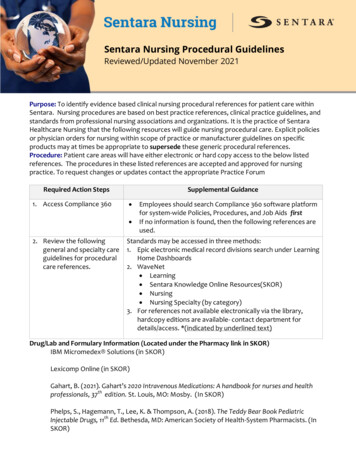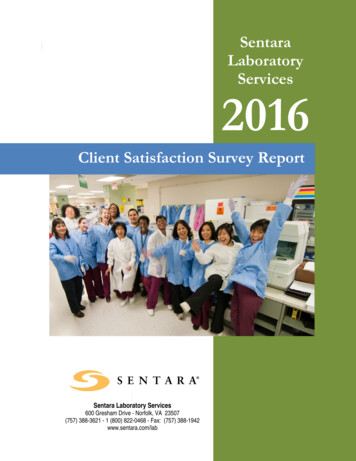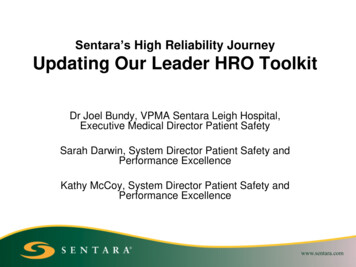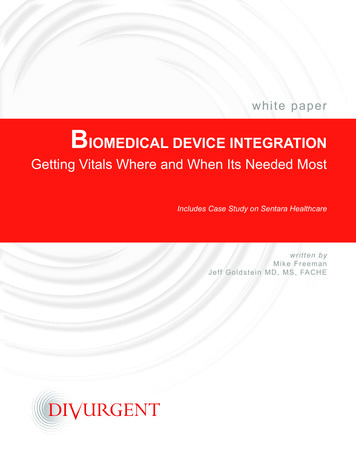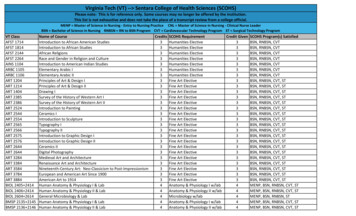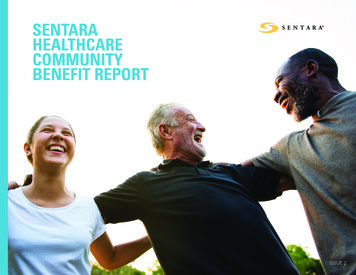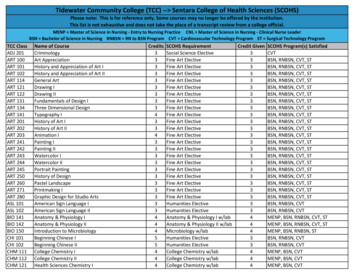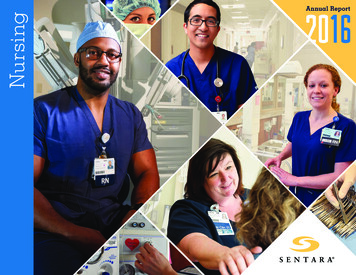
Transcription
NursingAnnual Report201 6
TABLE OF CONTENTSSENTARAHEALTHCARENURSING:Today andTomorrowWelcome to the 2016 Sentara Nursing Annual Report.Every year with our Sentara Nursing Annual Report,we take the time to celebrate the accomplishmentsof all Sentara nurses throughout the system, thesuccesses we’ve ensured and the challenges we’redetermined to overcome. This is our chance to stepback, examine our outcomes and plan what we mightaccomplish tomorrow. Challenging trends are emerging,from cost pressures and a shortage of healthcareproviders to a need for transparency with costs,safety and outcomes and uncertainty about federallegislation. These trends push us to be forwardthinking and flexible, and Sentara nurses must lookbeyond daily demands to anticipate the impact ofthese changes, as we also deliver the promise ofour mission – Improve Health Every Day. Here,we explore five keys to doing so successfully:PAGE32017 Sentara Nursing Strategic PlanOur leaders once again directed our efforts with an updated 2017 systemwidestrategic plan and we crafted our complementary nursing strategic plan. The nursing planlinks our vital roles to the Sentara Healthcare strategic imperatives. Customer Centricity,with Sentara employees viewing every service and every decision through a customer’s eye, isat the heart of both strategic plans.PAGE6Focus On Nurse-Sensitive Clinical IndicatorsClinical Quality and Safety are intertwined with every nurse’s responsibilities. Clinicalindicators, such as how many patients were injured from a fall and how many experienced acatheter-associated UTI, are top of mind for our nurses. Those numbers gauge how effectivelywe care for patients, and we regularly strengthen our resolve to improve them.PAGE14Build Nurse Retention Through Training and ScholarshipsWith strong retention rates, we’re more easily able to fulfill our strategic imperatives,especially Growth and Innovation. We choose the best nurses when creating our team. Inan effort to foster loyalty, in 2016 we introduced Periop 101 surgical orientation and theNurse Residency Program and further developed our simulation training. The David BerndScholarship provided additional support for nurses earning a BSN.PAGEPromote Professional Developmentshould never end, no matter your age or your professional position. Our2nurses2 comeLearningto us well trained, yet we offer on-the-job training for new and established nurses,and encourage them to earn a BSN, to secure professional certifications and to conduct and presentevidence-based research. Why? We want nurses who innovate as they deliver top-notch care.PAGE30Live the Professional Practice ModelThe Professional Practice Model (PPM) represents the Sentara approach to nursing,with shared governance at its core. As the center pillar says, nurses collaborate with thehealthcare team to use evidence-based practice in providing and organizing care. With theNurse Executive Council, specialty nursing practice forums, system nursing councils andsystem nurse-sensitive measure committees, we have nearly 30 teams supporting all of ourstrategic plan imperatives.
Annual ReportDear Colleagues,Every day more than 7,800 nurses atSentara Healthcare create a safe, highquality, exceptional experience for ourpatients and their family members. It is anhonor and a privilege to care for our patientsduring some of the most vulnerable timesof their lives. The passion, commitment, andprofessional excellence of our nursing staffis apparent in every interaction I observewhile rounding in our facilities.I watch the care and understanding eachSentara Life Care staff member displays totheir residents. I watch it in all of our acutecare facilities as our staff takes care of critical care, surgical-medical,and oncology patients. I hear about it in the many home visits ourHome Health and Hospice nurses make on a daily basis. Thank youto each and every member of our nursing staff for your dedicationto the Sentara mission to improve health every day.Our nursing staff has been a driving force in our 2016 quality initiatives.2016 was an amazing year for Sentara in exceeding all of our ClinicalPerformance Improvement (CPI) goals. Review the chart to the rightto understand the number of patient lives we have impacted!I want to share with each nursing staff memberhow proud I am of our achievements in 2016 andencourage each of you to contribute and be a partof our continuing journey to nursing excellence in 2017.Genemarie McGee, MS, BSN, RN, NEA-BCCVP, Chief Nursing Officer, Sentara HealthcareCLINICAL PERFORMANCE IMPROVEMENT 2016TEAMMEASUREMENTPATIENTS IMPACTED1 Readmits12 of 15 Divisions483 fewer patients readmittedwithin 30 days2 APC/PC/Hospice8 of 12 Hospitals181 more patients dischargedto hospice care3 CDI10 of 12 Hospitals12 fewer patients with CDI4 Wrong Events9 of 12 Hospitals10 fewer patients with a wrong eventa) Patient Flow21 of 29 Targets630,000 patients spent 48,159fewer hours in the EDb) Mammo18 of 21Breast Centers1,852 patients collectively spent17,038 fewer days waiting for a biopsy55% New Patients5,044 more PT appointmentsavailable within 7 to 14 days5 of 5 Centers118,176 more contacts answeredwithin 30 seconds5 AccessThank you for all your energy and efforts in meeting our 2016 CPI goals.We also continue on our professional excellence journey withgreat improvements in professional certifications and number ofBSN prepared nurses employed. We have six Magnet designatedhospitals, two more on their journey to Magnet designation, andone of our long-term care facilities working toward Pathways inExcellence designation. Our scholarly work continues to grow eachyear. We are contributing to evidence-based nursing care.201 6c) AppointmentAvailabilityd) ContactCentersAs of January 24, 2017Source: Sentara Clinical Performance Improvement(details on inside back cover)SENTARA NURSING1
Plan for the Future: Earlier this year, our leadersSentara Healthcarecreated a systemwide strategic plan, which serves asa guide for the development of a nursing strategicplan that is aligned with the system plan.ClinicalQualityand SafetyCustomerCentricityGrowth andInnovation22 0 17 S T R AT E G I C P L A NAchieve better health for our members and patients1Partner with patients, members and their families to achieve better healthoutcomes and help prevent future problems.Align with clinicians to reduce unnecessary variation, achieve top quartileperformance and lower total cost of care.Provide high-quality comprehensive care that is cost-effective for all membersand patients and meets the needs of the growing Medicare population.Provide an exceptional, desired experience2Redesign access and service delivery based on the desired experience of ourmembers and patients.Address the unique needs of those with chronic disease.Form lifelong relationships with customers assisted by personalized digital solutions.Grow existing and new markets3Grow organically in our existing markets.Build innovative care delivery models and health plan products to attractand retain new customers.Expand to new markets through mergers and affiliations.
Sentara Nursing2 0 17 S T R AT E G I C P L A NAchieve ClinicalPerformanceImprovement (CPI)1.1Achieve 3 of 4CPI (2017) goals:Readmissions,Hospice, C.diff,& Wrong EventsIntroducing the 2017 Sentara Nursing Strategic Plan.Created in support of the 2017 Sentara HealthcareStrategic Plan, this plan will provide the vision anddirection for nursing in Sentara for the next three years.Ensure all front-line clinicalstaff have access to and utilizeidentified nursing expertsDecrease care variation applyingevidence-based practice toachieve nurse-sensitive goals1.2Meet 2017 Pressure Injury goal1.3Identify all nursing expertsMeet 2017 Falls with Injury goalEnsure frontline clinical staff have access to nursing expertsAchieve 3 of 4 nurse-sensitive goals:Vaccines, CAUTI, CLABSI, VTEEnsure frontline clinical staff and nurse expertscollaborate to deliver evidence-based careindividualized to patient needsEnsure care delivery is based on unique needs and desires of patients and families2.1Meet 2017 ED Treat and Admit goalHome Health and MTI will meet Timely Initiation of Care goalMeet 2017 ED Treat and Release goalPartner with patients and families to anticipate andmanage care transition challengesSMG will meet 7-Day Follow-up goalExpand nursing capacity utilizing innovative staff retention and cost reduction methodsImprove retention of new RN graduates3.1Improve overall RN retentionImprove retention of APNs in Medical GroupImprove retention of LPNsin long-term careImprove selection and retention ofassistive personnelCoordinate supplemental staffing resourcesto cost effectively respond to staffing needsImprove retention of NCPs and CNAsPartner with materials management todecrease supply and print shop expensesReduce RN purchased labor expenseSENTARA NURSING3
Plan forthe FutureListed as number two on the 2017 Sentara Strategic Plan is Customer Centricity, and supporting that imperativeon the nursing strategic plan is expand access to appropriate care venues. We’ve been talking about this concept aspatient- and family-centered care for years, and now we’re taking our efforts to the next level as we redesign thedelivery of services based on the customer’s desired experience instead of our preference.4Sentara Nurse Executive Council Members, December 2016
GOAL: Improve the customer experience byconsidering the customer’s desired preferences.Cherika Britt, MSN, RNSystem Director for Patient ExperienceSentara HealthcareTODAY’S INITIATIVES“I started this position in October 2016, although I started withSentara 15 years ago. I’ve been part of the Patient and FamilyEducation Council, Patient and Family Advisory Councils and theReadmissions CPI Patient and Caregiver Engagement Team, to namea few. Now I provide system direction to interdisciplinary and crosscontinuum teams to improve the customer experience throughoutthe transitions of care. Patients are the most important members ofour team, and our ability to base decisions on their wants and needs,and not what’s easiest for us, is in their best interest.My passion comes from my husband who has suffered from achronic illness for a long time. I watch him navigate through thehealthcare system many times with fear and uncertainty. I sharein those feelings, even though I’m a registered nurse. I’ve keptthat in mind as I worked with teams in this job.One of our projects can help reduce hospital readmissions as weconsider the patients’ perspectives: We developed a video and abrochure titled ‘Preparing You for Leaving the Hospital’ to betterengage the patient and the caregiver in the transition. They’reavailable in eight languages and with subtitles and can be foundin our hospitals, on our website and through MyChart.”TOMORROW’S PLANS“In everything we do going forward, we need to ask, ‘What do wewant patients to say?’ I promote the answers provided in the ‘SixSteps for the Patient Experience Vision’ from the Mid StaffordshireNHS Foundation Trust:Why go anywhere else?They were expecting me.My care was planned with me and for me.They made me feel special; I was treated with compassion.They really knew what they were doing.Their support continued, and my quality of life was improved.”SENTARA NURSING5
FocusOn NurseSensitiveClinicalIndicatorsMeasuring means knowing, and for our nurses,knowing means being aware of how safely wecare for our patients. Our measures – of fallswith injuries, catheter-acquired urinary tractinfections, hospital-acquired pressure injuries,central line-acquired bloodstream infections,and other indicators – often tell a story of nurseswho diligently follow protocols and strive forexcellence. Yet, sometimes we face challengesthat can only be overcome with new proceduresor yet-to-be-identified solutions. The unknownfactor improves our care and our patients’safety and motivates each of us to look atour indicators with an inquiring mind anda commitment to be part of the solution.6Catherine Smith (left) pictured withBarbara Runk, MSN, RN, ACCNS - AG, CCRN
GOAL: Decrease the CAUTI rate (theCatherine Smith, DNP, RN, CCNS, CCRNnumber of catheter-associated urinarytract infections) in 10 out of 12 hospitalsto prevent the need for additional treatmentfor patients and longer hospital stays.Professional Practice ManagerSentara Williamsburg Regional Medical CenterTODAY’S INITIATIVES“Our number of CAUTIs crept up, sowe wanted to offer evidence-basedrecommendations to lower the numbers.Since March 2016, I’ve been leading asystemwide team with 20 to 25 peoplefrom nurses and microbiologists toeducation department members andphysicians. We updated our review practicefor Foleys and standardized Foley care sothat every hospital is doing the same thing.We established protocols, developed newjob aids and adopted a decision-making treein practice from Sentara Obici Hospital.Before inserting a catheter, every nurse nowasks the same questions: ‘Does the patientreally need this? Would something else work?If not, am I following the CAUTI preventionSENTARA HOSPITALS CAUTI RATE3.00CAUTI RateCAUTI Rate2.50Trend2.00Goal (Top Quartile)1.501.000.500.002012201320142015Source: Sentara Infection Control Report - NHSN DUR Device Inf Rate CC-NCC2016bundle?’ Thinking this way, along with providingproper Foley care and re-evaluating the needfor a catheter every shift, can lower our deviceutilization ratio and reduce CAUTIs. By the endof the first quarter in 2017, we accomplishedour goal to have over 7,000 clinical employeescomplete computer-based training and wentlive with the new protocols.”TOMORROW’S PLANS“Looking ahead, our team wants to partnerwith a medical company that manufacturesproducts and evaluates services, and conducta life cycle study. Through that process, weconsider every aspect of catheters and foleys,from which catheter to select to when todiscontinue its use. We’ll keep on questioningif and when it’s appropriate to have a patientuse a catheter and also create standards forsending a urine culture for review. We needto ask, ‘Are we culturing appropriately?’There was a time when we would order one ifwe weren’t sure about the patient’s conditionand that is no longer the case. Every step wetake to re-evaluate requires a lot of teamwork.”SENTARA NURSING7
Focus On Nurse-Sensitive Clinical IndicatorsGOAL: Decrease the number of falls and fallswith injuries for hospital patients to protect thepatients from injuries and longer hospital stays.Lori Lambert, BSN, RN, CMS-RNClinical Nurse ManagerSentara Virginia Beach General HospitalSentara Virginia Beach General Hospital Falls Work Group MemberSystems Nurse-Sensitive Measures Committees – FallsTODAY’S INITIATIVES“In June 2016, I took over the hospital Falls Work Group. Participationhas grown in our monthly meetings. At the end of 2016, we saw adecrease in our falls with injuries and that’s encouraging. FromAugust through December, we met goal. Prior to that, we had beenin the red, so to speak.Our biggest initiative was to introduce a gold standard of equipmentfor fall prevention; it was a collaborative, systemwide effort wherewe looked at evidence-based practices. We put it in place in autumn.For every patient who is at risk for falls, it includes two fall mats, onewalker, one gait belt, one bedside commode and one chair alarm. Thetheory is, if the equipment is readily available in the room, the nurseshave it to use and they can quickly prevent a fall.8
Leadership made every effort to hold nurses accountable, becausewe had seen an increase in falls with injuries. One of our otherstrategies was to revise our fall recap tool, a one-page, quality reviewdocument we complete after a fall. We look at what we did right,what we could have done better and the gaps in our care. Part ofwhat we added was a safety huddle. When a patient falls, the chargenurse on the unit will, in real time, share the lessons learned. We doso at the start of each shift for three days; that’s six shifts of staff,instead of sharing it in our Falls Work Group once a month and thengoing back to talk to the other nurses about it. That change wasvery impactful on our falls with injury rate.”TOMORROW’S PLANS:“We did a lot of work with the system team to get some plainlanguage, medical jargon-free education materials for the patientsso they can understand how to help prevent falls. This includes tentcards that sit on the bedside table with a reminder for patients to‘call before you fall’ and ‘use your call light.’”SENTARA HEALTHCARE INPATIENT FALLS WITH INJURY RATE0.90Falls with InjuryFalls with Injury Rate0.80Trend0.70Goal (Top 0152016Source: Sentara Tracking Action and Reporting System (STARS)SENTARA NURSING9
Focus On Nurse-Sensitive Clinical Indicators“Our educationand the supplieskeep the patientssafe, and we’ve seena decrease in hospitalreadmissions, thanksto us workingwith them andkeeping them ashealthy as possible.That’s our goal.”10
GOAL: Decrease the number of central line-acquired bloodstreaminfections (CLABSIs) experienced by patients in all care settings toeliminate related patient illnesses and reduce hospital readmissions.Megan Walsh, RNSentara Home Care ServicesTODAY’S INITIATIVES“I visit between six and eight patients intheir homes every day. I want them andtheir family members to stay up-to-date onthe techniques to prevent CLABSIs. They alluse an IV line in some way, and I teach themand keep reminding them to clean theirhands, use an antiseptic wipe and to carefullyflush the line. We have to be meticulouswith dressing changes. I give hands-oneducation so the patient can be independent.Our education and the supplies keep thepatients safe, and we’ve seen a decrease inhospital readmissions, thanks to us workingwith them and keeping them as healthy aspossible. That’s our goal.”TOMORROW’S PLANS:“Our home care patients often have orrecently had an infection, and that fact setsthem up for a CLABSI. They’re definitely at risk.We have to remain vigilant every time wemeet and review the proper way to do things.”SENTARA HEALTHCARE CLABSI RATECLABSI Rate0.70Trend0.60Goal (Top Quartile)In September 2016, we introduced a kit forPICC line removal. It includes everythingneeded for a safe removal – sterile gloves,alcohol wipes, antiseptic cleaner, gauze anda sterile dressing. It’s all packaged in plasticand sealed so it’s sterile. I have a few sayingsI use over and over: ‘A lot can be preventedby having clean hands.’ ‘When in doubt, andyou’re not sure if you’ve cleaned something,wipe it with alcohol again. You can neverwipe a central line with too much alcohol.’CLABSI urce: Sentara Infection Control Report - NHSN DUR Device Inf Rate CC-NCCSENTARA NURSING11
Focus On Nurse-Sensitive Clinical IndicatorsChristopher Coombes, RNClinical Quality Initiatives CoordinatorSentara Halifax Regional HospitalTODAY’S INITIATIVES“I was brought in to look at our numberof HAPIs in November 2015 because I hadexperience in the emergency departmentwith HAPIs and had also worked in longterm care, where HAPIs can be a bigconcern. At 214 percent of our goal, wewere far in excess of our limit.GOAL: Reduce the number of hospital-acquired pressureinjuries (HAPIs) so that patients are not affected by possibleresulting complications and longer hospital stays.12I turned to two Sentara hospitals that were‘below’ – Sentara Martha Jefferson Hospitaland Sentara Williamsburg Regional MedicalCenter. Nicole Spence, a former ICU managerat Sentara Halifax Regional Hospital who’snow an accreditation manager, and I learnedso much from Carolyn Ramwell at SentaraMartha Jefferson Hospital and Cathy Beck atSentara Williamsburg Regional MedicalCenter. She and I formed a wound andpressure injury care team. We would roundto patients and see at what point nurseswere identifying pressure injuries.
We needed more than word-of-mouth inspreading our concerns about pressureinjuries being caught as early as possible; wewanted data to share with nurses. We joinedwith IT to create a skin injury daily report anduse the Braden score, a scoring system forpredicting a patient’s pressure injury risk. I’dround and do my own assessments and givethe nurses recommendations.documentation and at about the same timewe were integrating into the Sentara supplychain. The new, better supplies were likeparachutes coming out of the sky and savingus. Another nice coincidence fell in our laps:meetings were already planned with allinpatient and ED nurses for early 2016 to talkabout patient care. We added a 30-minutepresentation about HAPIs to that.We truly went through a metamorphosis. Ialso started attending new nurse orientationto talk about pressure injury prevention andWe knew part of our problem was that ourstaff was great at identifying a worseningHAPI, but we need to catch them early atstage 1. We want a culture of prevention.We’ve accomplished that, and our recentHAPI rate is at 50 percent of our limit.”TOMORROW’S PLANS:“We will always provide more educationbecause of turnover. We need to reiteratethe importance of catching pressure injuriesearly to the new folks. In the spring, we’regoing to be part of a WebEx summit onwound care; it’ll be shown in all theconference rooms for staff to watchas they’re able to.”HAPI Stg.2 or Greater / 1,000 AdmissionsSENTARA HEALTHCARE ACQUIRED PRESSURE INJURIES STAGE 2 AND GREATER 500.00HAPI Stage 2 and above rateTrend20122013Source: ET Nurse Data Collection Form (based on ET Nurse rounding)201420152016SENTARA NURSING13
Build NurseRetentionThroughTraining andScholarshipsGOAL: Improve nurses’ competency and comfort levels bytraining new hires, nurses transitioning to new divisions andnurses looking to perfect skills.The members of our nursing team are Sentara.As a nurse, you largely determine a patient’sopinion of us through both your personalinteractions and your attention to medicalcare. While you came to Sentara prepared, weanticipate that you’re open to further training,and your leaders are eager to support you withclasses, special programs and scholarships tohelp you obtain a BSN. We hope that byinvesting in you, you will return the vote ofconfidence with loyalty to Sentara as youremployer of choice. Only with strong nurseretention rates are we able to grow indelivering effective healthcare.14Nurses developing skills in the Simulation Lab.
Kathy Hochmiller, MS, BSN, RNManager, Simulation EducationSentara HealthcareTODAY’S INITIATIVES“A few years ago, Sentara centralized trainingfor our new hires and nurses moving to anew division. The Simulation Lab is offered inaddition to the hospitals’ resources; all but onehospital also has its own high-fidelity, ‘highrealism’ mannequin, too.Coming to the Simulation Lab allows thenurse to learn our policies, order sets anddocumentation. We’re a safe environment, setup the same as our hospital rooms with thesame equipment and mannequins that respondlike patients. Here the nurses have a variety ofskills validated – doing blood transfusions;caring for patients with hypo- or hyperglycemia;responding if heart failure turns into a stroke.Our most popular training is Code Blue.The biggest groups we have are in our new hireimmersive simulation labs. In 2016, we conductedan extensive review of this training and mergedsome topics and extended the time spent on others.Lots of studies have shown how challenging itis to transition from nursing school to a job, andwe make that transition easier. The nurses getclinical knowledge and practice reasoning skills.We see if they notice changes in a patient’scondition and know how to interpret lab results.Do they understand when to ask for help?Do they know how to work with a team andcommunicate well? We evaluate how they doand conduct a debriefing to reinforce the keypoints and correct knowledge deficits.Last year, we also conducted a skill blitz forSentara Life Care RNs. They then went backand reviewed the skills with their LPNs andCNAs. Plus, we saw an increase in our hospitalscoming to us for their nurses’ annual skill days,when the nurses review everything they do.”TOMORROW’S PLANS“We’ll be working with the integrated caremanagement folks soon and conductingsimulations with RNs and social workers. They’llpractice communication between patients,staff members and physicians. In the next fewyears, we’re hoping to apply for accreditationfrom the Society of Simulation in Healthcare.”2016 NURSE TRAINING552Simulationeducation classes7,7 9 631,31 9Simulationeducation learnersLearner hoursSource: Clinical Education approximate2016 simulation totalsSENTARA NURSING15
Build Nurse Retention Through Training and ScholarshipsLisa Ortiz, BSN, RNCardiac Intermediate Care UnitSentara Heart HospitalTODAY’S INITIATIVES“I felt a little intimidated to come straightout of nursing school and into my job, eventhough I had worked as a care partner. I hada 12-week orientation, but it felt kind ofshort, so I was glad to learn about the NurseResidency Program. We get together once amonth for four hours and listen to speakers,review skills and research evidence-basedpractices. My sister is at Sentara LeighHospital and is part of their group, too, soother nurses in different locations are doingthe same as me.16
GOAL: Improve nursing care atthe bedside and foster a supportivework environment through theNurse Residency Program, a 12-monthinitiative introduced in 2016 for nearly500 newly graduated nurses.I’ve liked it all -- practicing wound care, hearing Vice President/Nurse Executive Grace Myers speak, sharing ‘tales from thebedside.’ The sharing helps you get the support you needfrom your co-workers. They understand what you’re facing.We identify with each other even if we’re in a different unitand have different responsibilities.I value all the knowledge I can obtain. Patients come to youwhen they’re the most vulnerable, either facing a chronicillness or having had a life-changing surgery. I love interactingwith them and the Nurse Residency helps me change anyfear or any uncertainty to confidence.”TOMORROW’S PLANS:“Our cohort is working on our own evidence-based nursingproject. We’re creating a presentation and will share it withthe other nurses.”Sentara Nurse Residency ProgramBY THE NUMBERS12Hospitals26Cohorts53039804Residents startedprogram in 2016Graduates in 2016Hours of seminartime completedin 2016Source: Nurse Residency Program System CoordinatorsSENTARA NURSING17
Build Nurse Retention Through Training and Scholarships18
GOAL: Assist nurses in earning their bachelor’s of nursing withfinancial support awarded through the former Sentara HealthcareCEO David Bernd RN to BSN Scholarship.Yolanda Browne, BSN, RN, CMSRNUnit CoordinatorSentara Leigh HospitalTODAY’S INITIATIVES“I’ve worked at Sentara for about 20 yearsand as a unit coordinator, I agreed to earnmy BSN. I started at Tidewater CommunityCollege in 2014 for my prerequisites andthen chose Sentara College of HealthSciences. It was both the best school andthe least expensive program I could find.The teachers were so supportive, and Icould complete classes online, and planstudying around my schedule of three,12-hour shifts a week.In 2015, I applied for the Bernd scholarship.I had two children who were planning oncollege and knew I’d need the money. Ithought at first maybe I’d have to take asemester or two off because of the lack offunds. But that didn’t happen when I wonthe scholarship. I was really happy becausewith the scholarship, tuition discount andreimbursement, I didn’t have to pay for manyclasses out of my own pocket. I think it wasone or two classes only. I graduated in May2016. The degree has helped me see theoverall picture of nursing and the big pictureof healthcare, how everything fits together,and to appreciate the financials as well.”TOMORROW’S PLANS:“I encourage the nurses who work for meto get their degree now. I have five or six ofmy nurses in the same program I graduatedfrom. I say to all of them, ‘If I can do it, youcan do it.’”Thanks to the generous support andencouragement of the three SentaraFoundations, there were 168 SentaraRN scholarships awarded to supportRN to BSN education.885822Hampton RoadsRMH FoundationMJH Foundation168Sentara RNscholarshipsawardedSource: Sentara FoundationsSENTARA NURSING19
Build Nurse Retention Through Training and Scholarships“I got to see thereasons behind whyyou do what you do.We were taughtall the ins and outsof all aspects ofthe OR, so I cananticipate theteam’s needs.”20
GOAL: Improve nurses’ skills in the operating room (OR) andMelissa Wilson, RNincrease retention rates through the Perioperative 101 SystemNursing Initiative, a program introduced at Sentara Healthcare in2016 for nurses new to the OR. More than 1,500 hospitals haverelied on the initiative to reduce turnover by up to 25 percent.Circulator, Operating RoomSentara Albemarle Medical CenterTODAY’S INITIATIVES“I graduated with my RN in July 2016 andright away got my job and started in thePeriop 101 class. They had told me about theprogram during my interview and that facthelped me pick this job. In college, I didn’tlearn all the OR skills; it’s a totally differentworld from college to a real OR. A lot ofcolleges don’t teach a specialty to a student.The class was about five weeks and prettyintense and very informative with a mix ofwebinars, classes and shadowing. I thinkthey should adopt a program like this in allspecialties. I got to see the reasons behindwhy you do what you do. We were taughtall the ins and outs of all aspects of the OR,so I can anticipate the team’s needs.It taught me to be a good leader and howto be assertive and to know when to speakup. It’s all about communicating and workingas a team. I also liked learning aboutevidence-based practices so I know thebest way to do things. We’re
to each and every member of our nursing staff for your dedication to the Sentara mission to improve health every day. Our nursing staff has been a driving force in our 2016 quality initiatives. 2016 was an amazing year for Sentara in exceeding all of our Clinical Performance Improvement (CPI) goals. Review the chart to the right
